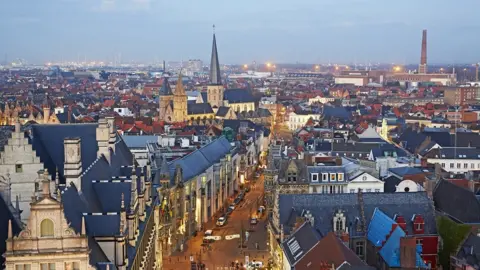Oxford traffic schemes 'will bring pros and cons' - Belgian politician
 Getty Images
Getty ImagesPolicies aimed at reducing congestion - like the one in Oxford - can bring both economic threats and opportunities, according to a Belgian politician.
Staff and councillors have suffered extreme abuse over plans to set up traffic filters in Oxford.
Filip Watteeuw, deputy mayor for mobility in Ghent, said the key to success was to bring social, cultural, and economic benefits.
Ghent introduced its circulation plan to remove through-traffic in 2017.
Andrew Gant, councillor for highways at Oxfordshire County Council, said: "Let's not think [Oxford] is some sort of back of the envelope, wild-wizard scheme that's never been tried before.
"There are plenty of cities that use this and it really works well."
He added: "Places like Ghent, some cities in Italy, Verona... there's so much more we can do for this wonderful city for residents, for tourists, for everyone."
Low Traffic Neighbourhoods (LTNs) block residential streets using bollards or planters, to stop vehicles using them as cut throughs.
LTNs introduced in Cowley have since been made permanent. Another trial is under way in east Oxford.
The council has also agreed to implement traffic filters on six main roads into the city.

There have been protests, and some bollards were vandalised, with the council spending £100,000 on more robust ones.
Restaurant owner Clinton Pugh said many businesses in the area were struggling to survive.
"There's been a gradual decline... of people not being able to get to the Cowley Road, to the point where our turnover has dropped.
"They can't find anywhere to park, single yellow lines have been removed, the congestion has been absolutely terrible."
'Intense'
Ghent's system consists of a car-restricted zone in the city centre, with the rest split into six sectors.
Cars cannot drive between zones, and must use the ring road.
Mr Watteeuw said: "We had a preparation time of two and a half years but we implemented it in one weekend. Everything changed in one weekend."
The plans were controversial when announced in 2014.
"There was a rough debate," Mr Watteeuw explained. "There were many questions and concerns and that's normal.
"I got death threats and I had police surveillance for six weeks because they were afraid... it was very intense."
 Getty Images
Getty ImagesA report by Transport Mobility Leuven revealed that car use by residents decreased by 7% two years on, with cycling up 60%.
Air quality had also improved, with pollution dropping by 18%.
But a consumer survey showed 44% of people said they visited shops less in the city centre.
Mr Watteeuw said: "I never dreamed that it should have such an impact, it's really one of the big moments of the city."
He added: "Economically there are threats and there are opportunities… we should have also thought about, for example, what will happen with the deliveries for the shops and the enterprises."
He said he hoped solutions could still be found with those affected.

Follow BBC South on Facebook, Twitter, or Instagram. Send your story ideas to [email protected].
